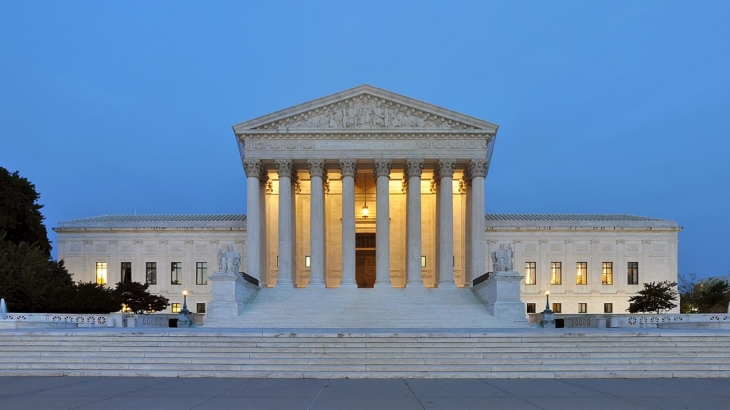Principle of a Judicial Branch for Ensuring Justice Without Political Interference
 Essay Read by Constituting America Founder, Actress Janine Turner
Essay Read by Constituting America Founder, Actress Janine Turner
The United States Constitution does not say much about the Judiciary, listing it third among the articles dealing with the main institutions of government. For some, this implies that the Judiciary was intended to be last in order of importance and the most insignificant of the institutions overall. While the three branches were intended to be equal in terms of legitimacy and functionality, they were not equal in terms of power. The Legislature wielded the awesome power of the purse and directed the affairs of government. The Executive held the only slightly less impressive power of the sword and executed the will of the Legislature. But what of the Judiciary? What power does it hold and what was its role in constitutional government intended to be?
One might be forgiven for thinking that Article III was something of an afterthought. There is a sense to the Article of being incomplete and not fully thought out. It begins by saying that the judicial power shall be given to a Supreme Court of the United States, but then leaves a lot unsaid. The Article never defines what the judicial power is or how it is used. It never explains the nature of the judicial power or how the Judiciary might go about using it. Its existence in the Article is a mystery. The Article then goes on to tell us only a little about the Court. Its size will be determined by Congress. Judges will be appointed by the president and confirmed by the Senate. Yet no qualifications are listed to be a Supreme Court Justice. There is no age requirement, no experience requirement. In fact, a person does not even have to possess a law degree.
The Article continues saying that the judges will hold their tenures for life on terms of good behavior, a provision justified to insulate judges from the whims of public opinion that is much more likely to sway the other branches of government. Following this, there is the Cases and Controversies Clause outlining what kinds of cases the Supreme Court can hear. This includes, controversially, cases under the equity power which is not clearly defined by the Constitution. A distinction between original and appellate jurisdiction comes next, followed by some clauses dealing with jury trials and trial for treason. And that is it. Compared to what preceded it in Article I and Article II, this is not much.
The lack of content in Article III, according to one of the Founders, was by design. It was a reflection on the nature of the institution and the more subservient role it played in American constitutional government. In Federalist 78, Alexander Hamilton gave a defense of the Judiciary and argued that the Court possessed neither force nor will, but merely judgment. This made the Court the “least dangerous” branch of government and the least threatening to the Constitution. According to Hamilton, “it proves incontestably that the judiciary is beyond comparison the weakest of the three departments of power; that it can never attack with success either of the other two; and that all possible care is requisite to enable it to defend itself against their attacks.” This further adds to why the judges need lifetime tenures and such radical independence – it is the only way to ensure justice without the interference of the political branches of government or public opinion.
So, we see the task of the Supreme Court as interpreting the laws passed by Congress, exercising its judgment over what those laws mean and how they should be applied. But is this all? Not according to Hamilton and other Federalists. The Court also had a more fundamental duty to protect the Constitution. It preformed this function through the power of judicial review. Judicial review is the power of the Court to determine that government actions conflict with the Constitution and are, therefore, null and void. It was first used in a Supreme Court case, Marbury v. Madison, but was held to be a part of the Court’s power by many Federalists at the founding. Anti-federalists, such as Brutus, denied that the Court possessed this power and claimed that if it had been intended to give the Court such an extraordinary power, the Founders would have written it into the Constitution. The president cannot not even completely override a bill passed by Congress, so it would be incredible if this unelected body of judges could do what the president could not. If the Framers had intended judicial review, they would have enumerated it.
Federalists countered by saying that the power of judicial review was enumerated when Article III said that the judicial power shall be vested in a Supreme Court. What else could the judicial power be but the power of judicial review? Though it was not stated explicitly in the Article, it was clearly implied in its language. But there was an even stronger argument for judicial review. If the Court lacked this power, how would it play a role in the separation of powers and checks and balances? The Court would effectively be relegated to playing the role of an advisory body, making suggestions to the other branches about constitutionality but not having the power to compel anyone to listen. This would effectively destroy the purpose of an independent judiciary and render the Court not just weak but impotent. Thus, judicial review must be part of the design of constitutional government and a vital part of the principal of the judicial branch.
 Eric C. Sands is Associate Professor of Political Science and International Affairs at Berry College. He has written a book on Abraham Lincoln and edited a second volume on political parties.
Eric C. Sands is Associate Professor of Political Science and International Affairs at Berry College. He has written a book on Abraham Lincoln and edited a second volume on political parties.




Join the discussion! Post your comments below.
Your feedback and insights are welcome.Feel free to contribute!